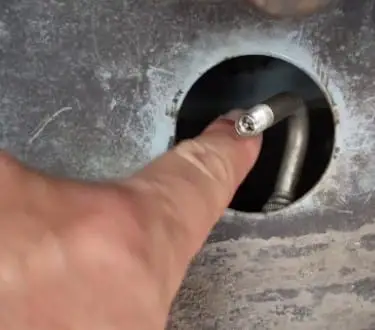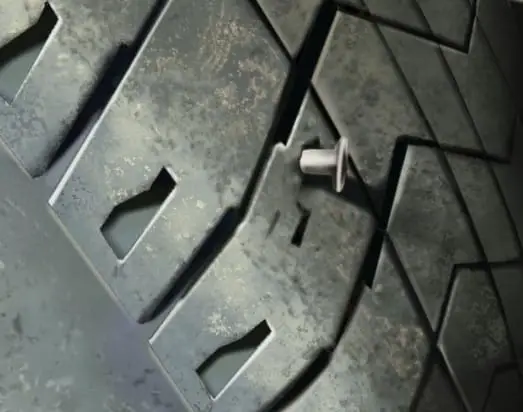A car can not sit on a flat tire for even a day. This is because, the rims of a car, fundamentally, are not designed to withstand the entire weight of the car without support from the tire. Hence, prolonged exposure may compromise the structural integrity of the wheel by causing the rim to bend resulting in mismatched tires.
Mismatched tires can in turn cause damage to driveline/drivetrain of the car.
Moreover, excessive pressure on the tire for long durations may result in weakened points and flat-spotting, which would ultimately call for the replacement of the tire, instead of repair.
Reasons why even new tires can go flat overnight:
1. Improper Sealing:
Improper sealing of the tire at the time of installation can cause even a brand-new tire to deflate.
2. Mounting Problems:

If the mounting surface of the wheel is damaged or corroded, it can disrupt the tightness of the seal between the wheel and tire. This can create an outlet for air and may result in a flat tire overnight.
Dented rims – often caused when your vehicle hits the curb or a pothole – may also be the cause for air leakage in new tires.
3. Defective Valve Stem:

A defective air valve can be the cause of air leakage in a brand new tire.
Although new tires usually come fitted with new valve stems, there does exist a possibility of the air valve not being in pristine condition. This could result in a constant but slow leak, which may lead to a flat tire overnight.
4. High Temperatures:
In summers, high temperatures cause the air in the tires to expand, resulting in increased air pressure. As the air pressure rises, so does the chance of having a leak and a deflated tire.
Can I leave a flat tire overnight?
Yes, you can leave a flat tire overnight. However, you should resort to this option only if it is absolutely unavoidable.
Your first priority should be to fix the tire immediately. Doing this can prevent any form of permanent damage to both the rim and tire.
In the unfortunate event of not being able to repair the tire immediately, the next best thing to do is to elevate the edge of the car with a jack. This will save the rim and the tire from bearing the whole weight of the car and prevent any permanent damage – which may require replacement instead of repair.
However, if the first two options are not viable, you can consider leaving the tire overnight.
The reason why this is least preferable is that the rims of a car are not designed to withstand the entire weight of the car without support from the tire. Thus, prolonged exposure may compromise the structural integrity of the wheel by causing the rim to bend.
Moreover, excessive pressure on the tire can cause weakened points, which can not only cause an irregular point of contact between the road and the tire but a
lso decrease the life of the tire.In short, yes you can leave a flat tire overnight. But you should try to have it fixed as soon as possible, to avoid any potential damage that may cause you further inconvenience in the future.
How can a tire go flat overnight?
A tire can go flat overnight due to a number of reasons:
Sharp Objects:

One of the most common reasons for a flat tire is a puncture, which may be caused by sharp objects such as nails, screws, shards of glass, or a piece of wood, etc. In some cases, the puncture might not be noticeable right away since the object remains lodged in the tire – thereby causing a slow leak.
Thus, you may only realize the flat tire, the morning after the puncture has taken place since air pressure in tires reduces gradually during the night.
Valve stem leak:
A damaged air valve is another common cause of overnight leakage in tires. The condition of a valve stem usually deteriorates with the passage of time, due to continual exposure to chemicals, dirt, and road debris.
A faulty valve stem could result in a constant but slow leak, which may lead to a flat tire overnight.
Tire bead Leaks:
Sand, small stones, and debris can get stuck in the tire bead, providing an outlet for air to escape through. This leak may cause the tire to deflate overnight.
Damaged wheels:
If the mounting surface of the wheel is damaged or corroded, it can disrupt the tightness of the seal between the wheel and tire. This can create an outlet for air and may result in a flat tire overnight.
Dented or bent out-of-shape rims – caused by uneven roads, collisions with curbs, potholes, or debris – can also be the cause for leakage overnight.
Vandalism:
Parking your car in the wrong neighborhood can also cause you to meet with a flat tire. Instead of a leak, it might just well be a teenager letting out the air in your car’s tires for fun. Simply reinflating the tires should be enough to reverse the deflated condition.
Heat:
Heat can also cause a flat tire. In fact, high temperatures are responsible for a large proportion of flat tires.
In summers, high temperatures cause the air in the tires to expand, resulting in increased air pressure. As the air pressure rises, so does the chance of having a leak and a deflated tire.
How long can you drive on a tire with fix a flat?
You can drive on a tire with fix a flat for 3 days or 100 miles (whichever comes first), as recommended by the manufacturer.
An important thing to note is that fix a flat is not a permanent solution to a deflated tire since it does not inflate the tire properly.
A number of factors come into play while determining the effectiveness of a tire with Fix-a-Flat:
Tire damage:
The effectiveness of a tire with Fix-a-Flat largely depends upon the size of the puncture. Ideally, it should be used for small punctures only, since smaller holes are easier to seal.
Any hole larger than 1/4th of an inch, would not be sealed properly and put the tire at risk for potential damage down the road.
Weather and Road Conditions:
Cold weather conditions aren’t suitable at all when it comes to using a Fix-a-Flat. This is because, at low temperatures, the sealant freezes thereby diminishing the effectiveness of the product.
The frozen sealant can also cause an imbalance in the tires. This can potentially put your and other people’s lives at risk on the road.
Driving on uneven terrain or dirt roads can also cause hamper the effectiveness of the sealant.
Amount of Sealant:
The amount of sealant used is another important factor in determining the life of a tire filled with Fix-a-Flat.
Using exorbitant amounts of sealant can cause permanent damage to the wheel’s rims, whereas using an inadequate amount of sealant may not prove to be effective in fixing the hole.
Can a flat tire damage the rim?
Yes, a flat tire can be quite detrimental to the rim.
If the car sits idle with a flat tire for an extended period of time, the structural integrity of the wheel will be jeopardized. This is because the rims of a car are not designed to withstand the entire weight of the car without support from the tire.
Damage to the rim can be rather severe if the car is driven whilst having a flat tire. This is because when you’re driving on a flat tire, you’re actually driving on the rim of the car, which can not only cause cracks and bends in the rim but also cause severe damage to the entire vehicle. It can lead to problems with alignment, brakes, suspension, rotor, and fender of the car, which can cost you a pretty penny.
How long you can drive on a flat tire without damaging the rim?
The answer to long you can drive on a flat tire without damaging the rim is not far at all. You can only drive a mile or two on a flat tire, at best, before the rim is damaged beyond repair.
Driving on straight roads while maintaining a slow speed of 15 to 20 mph is recommended.
Flat tires can be a nuisance. One, is that most drivers may have to experience at least once in their lifetime. However, having adequate knowledge of fixing and taking care of a flat tire can not only save you on the road but also from suffering a huge financial loss.
